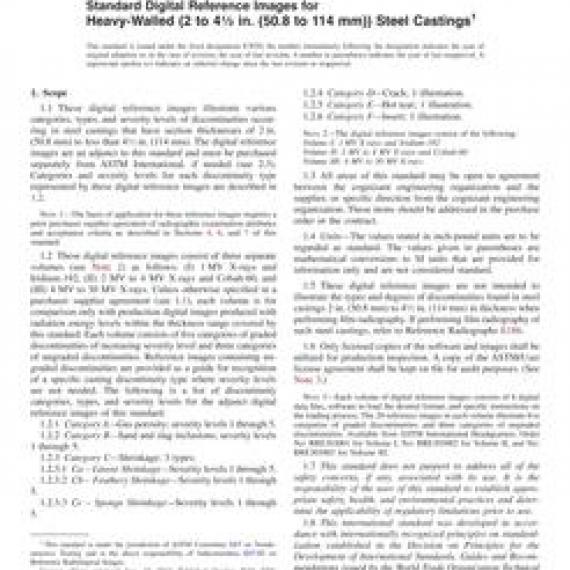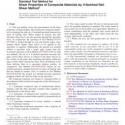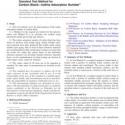No products
ASTM E3030-19
ASTM E3030-19 Standard Digital Reference Images for Heavy-Walled (2 to 4 1/2 in. (50.8 to 114 mm)) Steel Castings
standard by ASTM International, 08/15/2019
Full Description
1.1These digital reference images illustrate various categories, types, and severity levels of discontinuities occurring in steel castings that have section thicknesses of 2in. (50.8mm) to less than 41/2in. (114mm). The digital reference images are an adjunct to this standard and must be purchased separately from ASTM International, if needed (see 2.3). Categories and severity levels for each discontinuity type represented by these digital reference images are described in 1.2.
Note 1:The basis of application for these reference images requires a prior purchaser supplier agreement of radiographic examination attributes and acceptance criteria as described in Sections 4, 6, and 7 of this standard.
1.2These digital reference images consist of three separate volumes (see Note 2) as follows: (I) 1MV X-rays and Iridium-192, (II) 2 MV to 4 MV X-rays and Cobalt-60, and (III) 4 MV to 30 MV X-rays. Unless otherwise specified in a purchaser supplier agreement (see 1.1), each volume is for comparison only with production digital images produced with radiation energy levels within the thickness range covered by this standard. Each volume consists of five categories of graded discontinuities of increasing severity level and three categories of ungraded discontinuities. Reference images containing ungraded discontinuities are provided as a guide for recognition of a specific casting discontinuity type where severity levels are not needed. The following is a list of discontinuity categories, types, and severity levels for the adjunct digital reference images of this standard:
1.2.1Category A-Gas porosity; severity levels 1 through 5.
1.2.2Category B-Sand and slag inclusions; severity levels 1 through 5.
1.2.3Category C-Shrinkage; 3 types:
1.2.3.1Ca - Linear Shrinkage-Severity levels 1 through 5.
1.2.3.2Cb - Feathery Shrinkage-Severity levels 1 through 5.
1.2.3.3Cc - Sponge Shrinkage-Severity levels 1 through 5.
1.2.4Category D-Crack; 1 illustration.
1.2.5Category E-Hot tear; 1 illustration.
1.2.6Category F-Insert; 1 illustration.
Note 2:The digital reference images consist of the following:
Volume I: 1MV X-rays and Iridium-192
Volume II: 2 MV to 4 MV X-rays and Cobalt-60
Volume III: 4 MV to 30 MV X-rays
1.3All areas of this standard may be open to agreement between the cognizant engineering organization and the supplier, or specific direction from the cognizant engineering organization. These items should be addressed in the purchase order or the contract.
1.4Units-The values stated in inch-pound units are to be regarded as standard. The values given in parentheses are mathematical conversions to SI units that are provided for information only and are not considered standard.
1.5These digital reference images are not intended to illustrate the types and degrees of discontinuities found in steel castings 2 in. (50.8 mm) to 41/2in. (114 mm) in thickness when performing film radiography. If performing film radiography of such steel castings, refer to Reference Radiographs E186.
1.6Only licensed copies of the software and images shall be utilized for production inspection. A copy of the ASTM/User license agreement shall be kept on file for audit purposes. (See Note 3.)
Note 3:Each volume of digital reference images consists of 6 digital data files, software to load the desired format, and specific instructions on the loading process. The 28 reference images in each volume illustrate five categories of graded discontinuities and three categories of ungraded discontinuities. Available from ASTM International Headquarters, Order No: RRE303001 for Volume I, No: RRE303002 for Volume II, and No: RRE303003 for Volume III.
1.7This standard does not purport to address all of the safety concerns, if any, associated with its use. It is the responsibility of the user of this standard to establish appropriate safety, health, and environmental practices and determine the applicability of regulatory limitations prior to use.
1.8This international standard was developed in accordance with internationally recognized principles on standardization established in the Decision on Principles for the Development of International Standards, Guides and Recommendations issued by the World Trade Organization Technical Barriers to Trade (TBT) Committee.


































